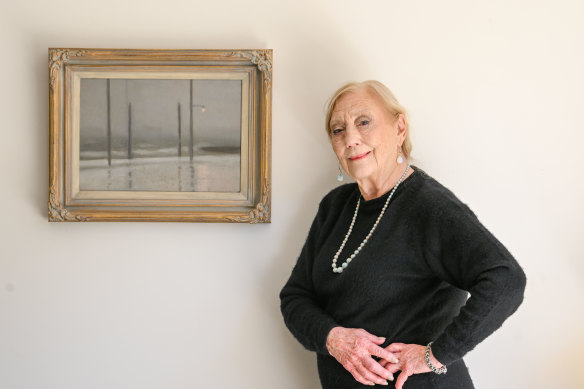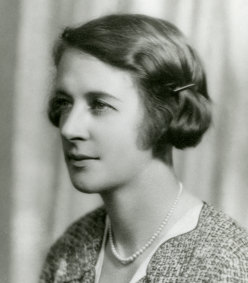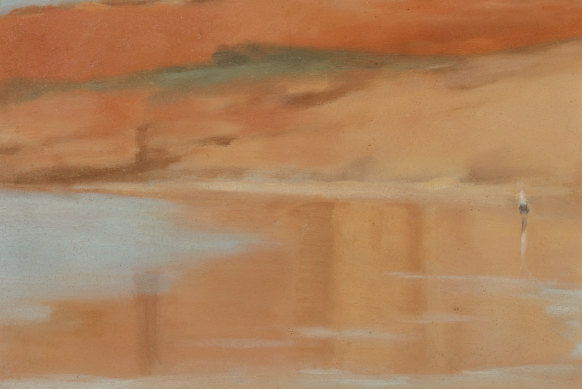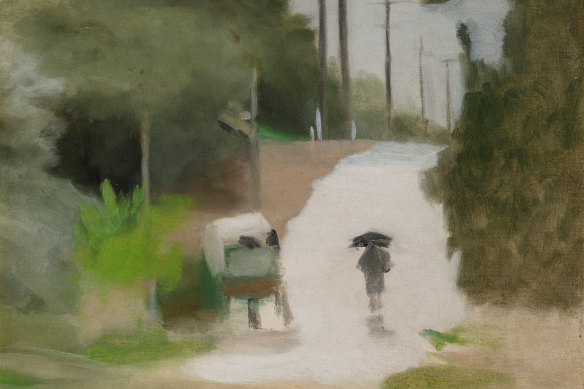‘People cry in front of her work’: Is this Australia’s greatest modernist?

Clarice Beckett had a power that very few artists possess, says Lisa Sullivan, senior curator at Geelong Art Gallery. Imbued with emotion and atmosphere, mood and nuance, Beckett’s art – even a century on from its creation – is strikingly contemporary and evocative.
The Australian modernist who died aged 48 in 1935 – from pneumonia contracted while she was painting outdoors – is celebrated in a new exhibition, Atmosphere, which opens at Geelong Art Gallery this weekend. Despite having shown work during her lifetime, Beckett was largely overlooked for 35 years after her death, in part thanks to politics in the art world, and in part, no doubt, because she was a woman.
Art historian Rosalind Hollinrake with Clarice Beckett’s painting Wet Night, Brighton.Credit:Eddie Jim
“[Her] late works verge on abstraction, she’s testing perception, the boundaries of abstraction… and [there’s a] focus on the mood and emotion that different places evoke,” says Sullivan.“We can only wonder where she would have gone had her life not been cut short.”
A prolific painter who often worked outdoors, Beckett captured images of everyday life in the suburbs and the changing world around her. Another constant was the beach around Port Phillip Bay, particularly Beaumaris, near where she lived. She focussed on atmosphere and would go back to the same places again and again, to capture them in different conditions.
“It helped her get to the essence of a location,” Sullivan says.
Art historian Rosalind Hollinrake, the woman responsible for resurrecting Beckett’s work, also “always had a feeling she was moving towards abstraction”.
“People cry in front of her work, as they did with Rothko,” she says.
“The silence is so powerful that it actually [seems to] create a sound. It’s the suggestiveness that some great artists get … Sometimes they just pull you up. You look at the painting, and it vibrates; it has an aura, like the Mona Lisa.”
“She brings to life the unseen, and what you feel.”
For many years, few people – in the art world and in her personal life – would speak freely to Hollinrake about the artist, and many secrets shrouded her story. One was the existence of an older brother, who had an intellectual disability, and who was never mentioned.
Clarice Beckett.Credit:Art Gallery of South Australia
According to Hollinrake, Beckett swam every morning of her life, winter and summer; loved theatre, drama, and classical music; and would have loved to have been an actress. She also loved cars.
All will be revealed in a much-anticipated biography, which Hollinrake hopes to complete before long. She is adamant Beckett’s contribution to the Australian canon of art cannot be underestimated.
She captures the first truthful impression when looking at her subject, Hollinrake says. “This is purely shapes of light and dark tones. There is no distracting detail, just the sensation of an illusion of reality. Yet they are powerfully full of feeling,” she says. “[Beckett] creates an intense atmospheric effect of the present moment, of a sense of place and the feeling of objects, such as cars, trams, wet roads or telegraph poles, suggesting some sense of them as being more than prosaic objects.”
Beckett’s Wet Sand, Anglesea, 1929.Credit:Courtesy Art Gallery of South Australia
Her landscapes are a key feature of the Geelong show. As Sullivan notes, they were painted during a transformative time for the artist: when she spent six months at a friend’s property in the western district and had a studio of her own for the first time in her life.
In that mid-1920s period, major artists like Arthur Streeton were doing big pieces like Land of the Golden Fleece, panoramic works celebrating the prosperity of farming. “[But] Beckett’s were small in scale, very much responding to the haze and the light and the temperature of the landscape in a series of works that have been likened to precursors to the abstraction of Mark Rothko,” Sullivan says.
“Her treatment of horizontal bands of colour [was] groundbreaking.”
Detail of ‘Rainy Day’, 1930, by Clarice Beckett. The painting is part of the Geelong Art Gallery’s collection and one of its most popular, according to Lisa Sullivan.Credit:Courtesy of the Geelong Art Gallery
That Beckett is known at all is something of a miracle, largely thanks to Hollinrake’s tireless work. Having established a gallery in Melbourne, Hollinrake – then known as Ros Humphries, as she was married to Barry – put out a call for female artists. When Beckett’s sister Hilda came in with six of Beckett’s paintings in 1971, it would change both their lives– and Australian art history.
Together they went to a property near Benalla where they found 2000-odd of the artist’s neglected canvases in a remote, open-sided shed; they managed to salvage 369.
“It is one of the biggest tragedies in art history,” says Sullivan. “That so much was lost is very sad but that so much could be salvaged is fantastic. Ros’ life’s work of resurrecting Clarice’s reputation is legendary.”
Atmosphere is at Geelong Art Gallery until July 9. Curator Lisa Sullivan is in conversation with Dr Ros Hollinrake on April 28.
In need of some good news? The Greater Good newsletter delivers stories to your inbox to brighten your outlook. Sign up here.
Most Viewed in Culture
From our partners
Source: Read Full Article



